Fact: A good customer experience begins when you follow reliable call center tips and reach effective call center management.
And that’s simply because happy and properly trained agents are able to provide better and often more empathic support. In fact, customer service can improve by as much as 450% over the course of five months by restructuring leadership and changing up the way coaching is done.
Such results usually come with increased productivity and overall happier agents and customers.
But getting there’s no easy feat.
To help you better structure the way you manage your call center teams, we’re going over our best call center tricks so you can improve performance without missing out on any detail or person.
10 call center tips and tricks for managing large teams
1. Leave Excel in the past
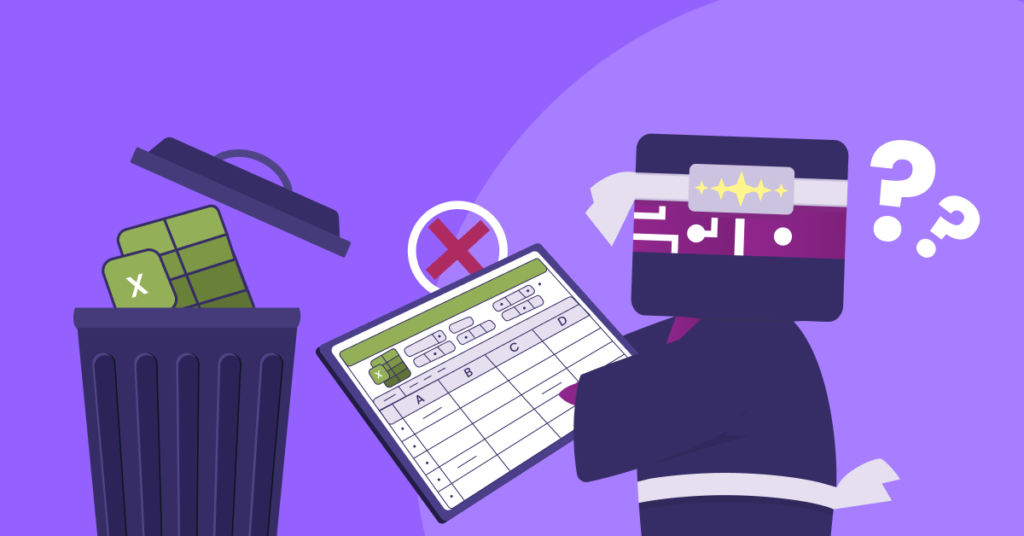
For years we’ve been talking about how all kinds of teams should avoid the Excel trap. Yet, it’s still one of the most popular solutions out there for managing agents and their schedules.
Sure, Excel is good for small teams or if you’re just getting started and have no budget to dedicate to such platforms. But for bigger ones, using it is counterproductive. Simply because it can’t handle complex customer service tasks and needs.
Here’s seven things Excel or similar spreadsheet programs can’t help you with when it comes to proper agent management:
- Handling large or interconnected data sets
- Ensuring error-free data when it comes to repetitive manual processes
- Staying away from data loss or corrupted files
- Providing a modern interface that will motivate your agents to use it every single day
- Integrating with other systems you’re already using as part of your tool stack
- Giving you a real-time look at operations
- Tracking and analyzing trends in time
For large support teams, gone are the days of relying on cumbersome Excel spreadsheets to manage call center operations.
Embrace modern call center management tools that offer advanced features tailored to your specific needs. These tools provide a centralized platform for managing customer interactions, agent schedules, performance metrics, and more. Say goodbye to manual data entry, formula errors, and limited functionality. By leaving Excel in the past, you can streamline your processes, save time, and make data-driven decisions with ease.
2. Give more autonomy and accountability
One of the core customer service call center tips to always rely on is trusting your agents more. Give both agents and managers the trust they need to make informed decisions without needing approvals every time.
Start by training them to make the right decisions. This alone should empower them to do their best even when faced with having to respond to queries or issues in real time. Give them a knowledge base to look back at when they need some context before making decisions. This document should include all relevant information about how your product, business, and operations work.
In our Customer Service Agent Empowerment Research, we found that agents want more autonomy in their roles and believe that having it would boost their performance.
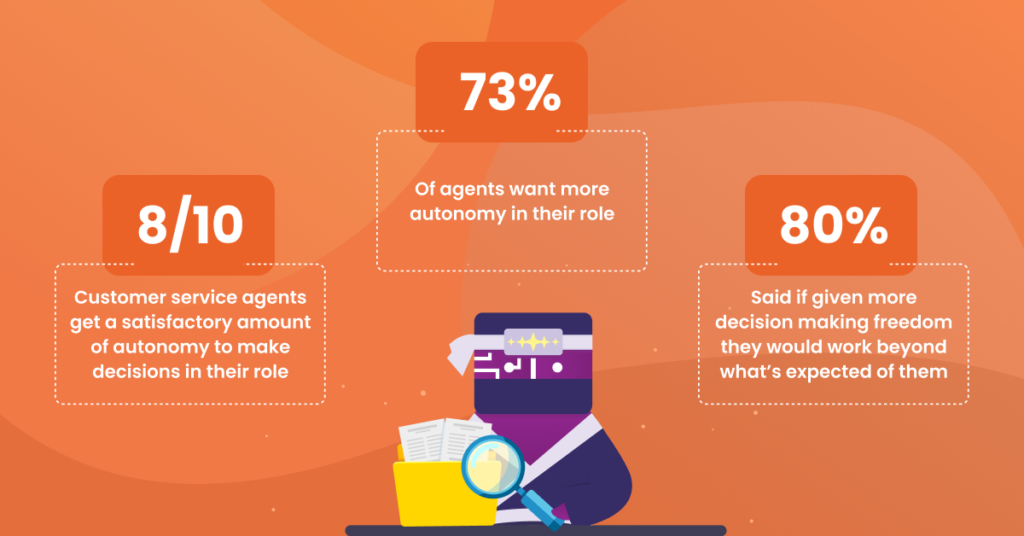
Empowering your agents with autonomy and accountability is crucial for their growth and the success of your call center. Encourage agents to take ownership of their work, make independent decisions within their authority, and find innovative solutions to customer issues.
This sense of ownership fosters a greater sense of job satisfaction, engagement, and personal investment in delivering exceptional customer service. Establish clear guidelines, provide training and support, and trust your agents to handle customer interactions with professionalism and care.
3. Gain more control and visibility into agent performance
The most important thing is to note that the more you know about your agents, the easier it is for you to know what you need to improve. Knowing exactly what a team’s blockers are also helps you save time and make error-free decisions when it comes to distributing tickets and keeping your agent team productive.
With Kaizo’s Scorecards, you can track activity in real time and use these insights for making data-driven forecasts. This way, you can look at every agent’s performance, compare results across different teams, and plan team capacity with the correct metrics in mind.
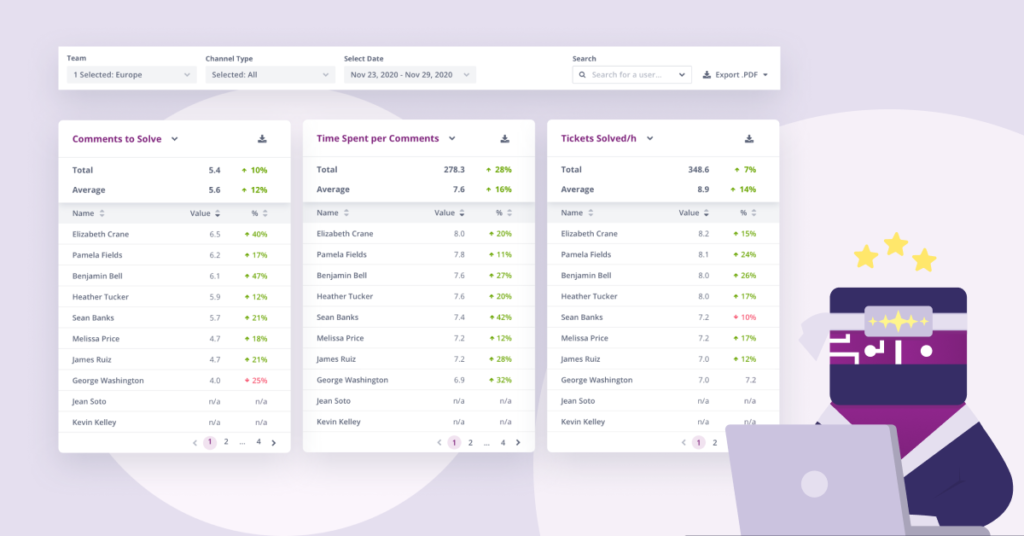
To effectively manage a large team of agents, you need comprehensive control and visibility into their performance. Modern call center management tools offer real-time dashboards and analytics that provide valuable insights into agent metrics such as call volume, average handling time, customer satisfaction scores, and more.
With this level of visibility, you can identify top performers, detect areas for improvement, and take proactive measures to enhance overall agent performance. By gaining better control and visibility, you can optimize resource allocation, identify training needs, and ensure consistent service delivery across your call center operations.
4. Bring all of your processes into one tool
Wouldn’t you just want to handle everything in one tool? Decluttering your tech space and finding a tool that replaces a dozen others means you’ll pay less and simplify your team’s work.
But the biggest benefit of keeping quality assurance, coaching efforts, and reporting in a single place is how easy it is to connect data like performance metrics, ticket results, notes, achievements, reports, etc. No more having to manually move insights from one tool to another and risking the accuracy of this data in the process.
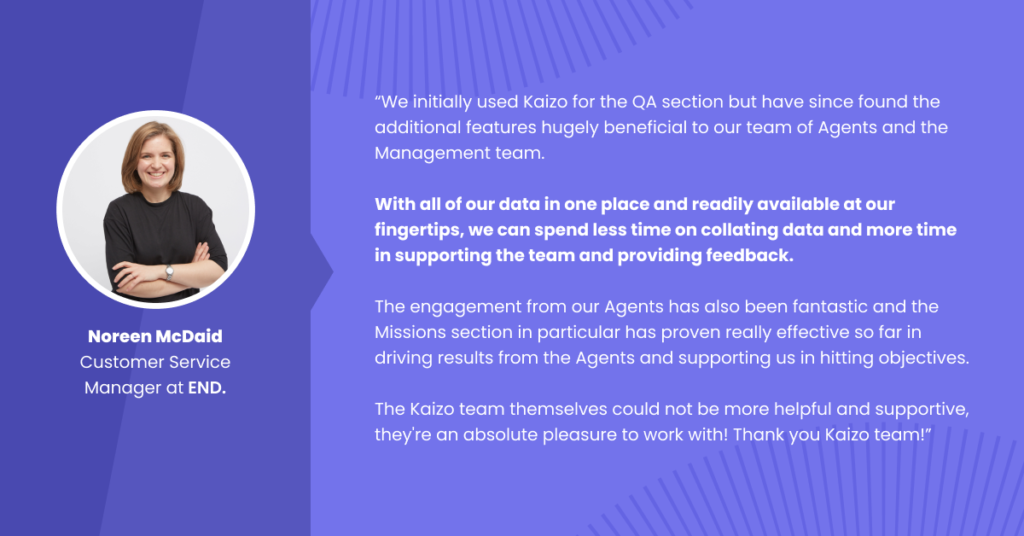
Consolidating your call center processes into a single, integrated tool can bring immense benefits to your team’s efficiency and productivity. Instead of juggling multiple systems and applications, a unified platform allows you to streamline workflows, reduce duplication of effort, and eliminate data silos.
By centralizing processes such as call routing, ticketing, knowledge base management, and customer data management, you create a seamless experience for both agents and customers. This integration ensures consistent information, easier collaboration among teams, and a holistic view of customer interactions, enabling you to provide faster and more personalized support.
5. Finetune QA
Quality assurance (QA) plays a pivotal role in maintaining high standards of customer service in your call center. To effectively manage a large team, it’s essential to fine-tune your QA processes.
Implement a structured QA framework that includes regular monitoring and evaluation of agent interactions. Define clear performance metrics and evaluation criteria aligned with your organization’s goals and customer expectations.
Provide constructive feedback and coaching to agents to help them enhance their skills and address any areas of improvement. By focusing on continuous QA, you can ensure consistent service quality, identify training needs, and drive performance improvement across your team.
Time to build a QA scorecard!
This can offer you a holistic look at how different teams perform. It should provide a clear picture of how well your team’s doing and what improvements you need to make.
One of the most common mistakes you could make when putting together QA scorecards is to make them too detailed. While this does mean you’ll get more accurate feedback, it does require A LOT of time. So with 10-15 categories for each criterion, it can take as much as an hour for the QA expert to cover everything. And that’s just for the first QA rating!
To avoid challenging your QA team unnecessarily, include only essential criteria for evaluating ticket quality. This gives your agents a clearer look at what they need to work on. Opt for 5-7 categories, each with 8-10 criteria points.
You can read more about the common mistakes you should avoid when creating QA scorecards by grabbing our “DO NOT” checklist.
Tip: Don’t forget to get our free QA templates to help you handle case handling, escalations, channels, and more.
6. Create a feedback loop for improved performance
Regular feedback helps call center agents identify the areas where they need to improve. On top of this, they can use feedback from supervisors and customers to set better goals for evolving in their roles.
Establishing a feedback loop within your call center is vital for fostering a culture of continuous learning and improvement. Encourage open and transparent communication channels where agents can provide feedback on processes, systems, and customer interactions. Actively listen to their insights, suggestions, and concerns, and take prompt action to address them.
Additionally, encourage agents to share best practices and success stories to inspire and motivate their peers. By creating a feedback loop, you empower your team to contribute to the success of the call center, nurture a collaborative environment, and drive performance improvement at both the individual and team levels.
Feedback comes in different forms. Supervisors can simply schedule one-on-one meetings or performance review sessions with them to discuss any blockers or performance data.
The easiest solution is to provide regular and actionable feedback through Coaching Cards. These allow you to leave coaching advice and even follow-up tasks every time you see an improvement opportunity for your agent. You can easily turn metrics into actionable advice and build a positive feedback loop that keeps agents motivated to keep growing.
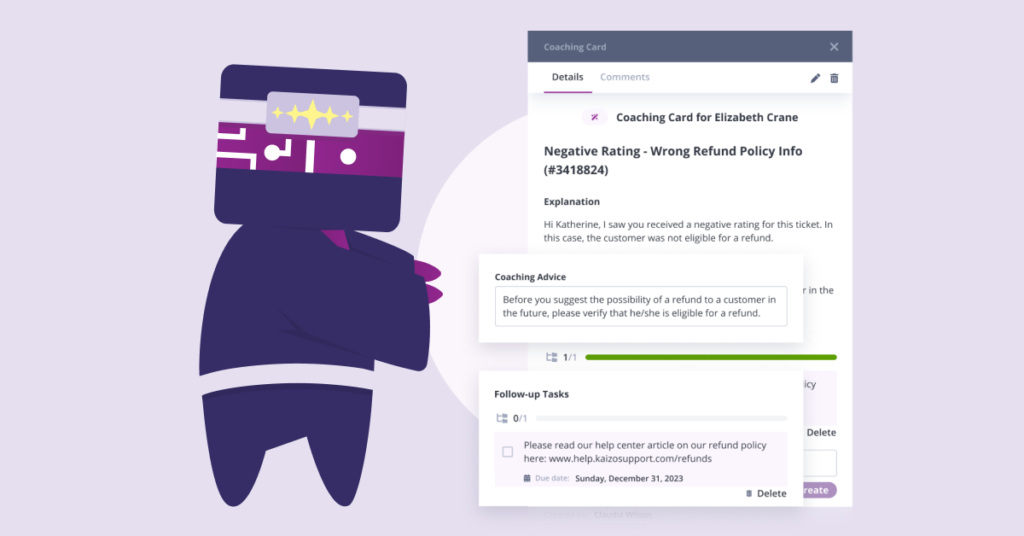
Tip: Don’t forget that it’s important to focus your feedback on the things agents are doing well as well! This keeps them engaged and makes them feel valued for their work.
7. Switch to automatic reporting
The old way of creating manual reports is time-consuming and only provides outdated stats within a short period of time. Unless you actively update them on a regular basis that is.
But you’ve already got so many other things to focus on. So keeping reports up-to-date isn’t really a core priority when you can automate the process.
By transitioning to automatic reporting, you can streamline and expedite the reporting process in your call center. Implement reporting tools or software that can automatically capture and analyze key performance metrics, such as call volumes, average handling time, customer satisfaction scores, and agent productivity. This shift allows you to access up-to-date and accurate data, visualize trends and patterns, and make data-driven decisions to optimize your call center operations.
Creating automated reports lets you get back your time and maintain accurate data you can always turn to in real time. This is one of the call center hacks: you won’t have to re-check the data every time you need to make a decision or plan your team’s capacity.
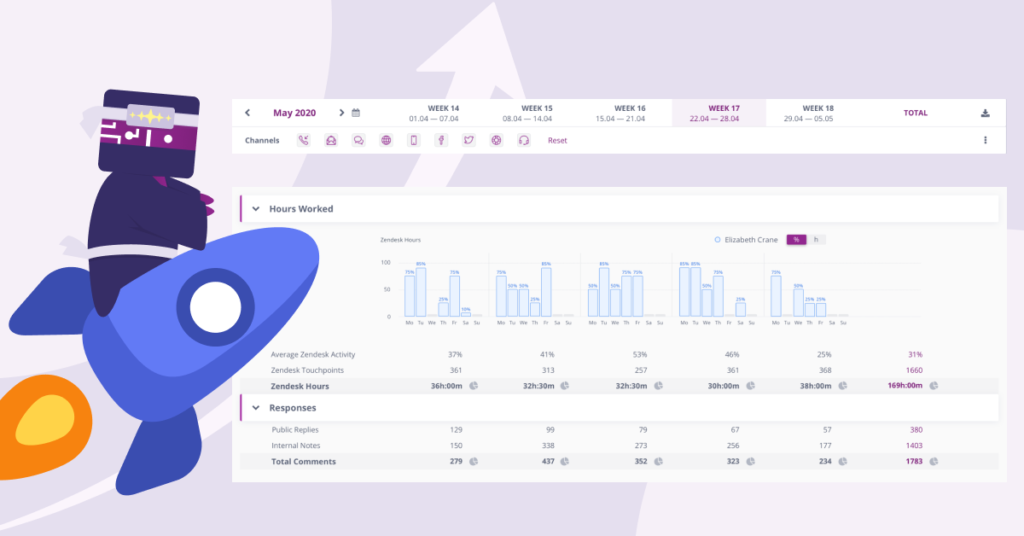
8. Motivate your agents to perform
Motivating your agents is crucial for maintaining their engagement, productivity, and overall job satisfaction. Recognize and appreciate their efforts through various means, such as employee recognition programs, incentives, or gamification techniques.
Set clear performance goals and provide regular feedback to help them track their progress and identify areas for improvement. Foster a positive work environment by promoting a healthy work-life balance, providing growth opportunities, and investing in their professional development. When agents feel valued, supported, and motivated, they are more likely to deliver exceptional customer service and contribute to the overall success of your call center.
Sometimes words aren’t enough to keep your call center team motivated. Instead, you’ll want to set up a rewards system that can make your agents feel appreciated and valued at work.
There’s dozens of different ways to set this system up. The most common:
- You could give your agents points for every call they handle or for meeting certain targets. These points could then be redeemed for prizes or vouchers.
- You could simply give agents a cash bonus for meeting targets. To speed this process up, use employee rewards solutions and choose from the different rewards options they provide like coupons, cash rewards, gifts, etc.
Whatever form the rewards system takes, it’s important to make sure that agents feel appreciated and valued. In addition to creating a rewards system, you could even use the regular feedback we just mentioned or team-building days to support the same goals.
9. Set things straight from onboarding day
A successful call center team starts from day one.
By taking the time to properly onboard new agents, you can set them up for success and ensure that they’re able to hit the ground running.
This is the best time to establish clear expectations from the start. Be sure to communicate the company’s vision and values, as well as performance expectations. New agents should receive comprehensive training on your company’s products or services, as well as on the systems and processes they’ll be using.
Effective onboarding sets the stage for agent success and helps them acclimate to their roles quickly. Clearly communicate performance metrics and goals to ensure agents understand what is expected of them. Establish a mentorship program or assign experienced agents as buddies to new hires to provide guidance and support. By laying a solid foundation during the onboarding process, you set your agents up for success and minimize potential issues down the line.
Remember onboarding can last for months if you’re planning on breaking your agents’ training into separate modules.
Approach training during onboarding systematically to make sure you’re communicating all best practices and policies. As an extra step, get your new agents an onboarding buddy or mentor to fully immerse them in the work environment and acquire general know-how faster.
Remember: Evaluate progress regularly. Conduct regular check-ins with new agents to ensure they’re meeting expectations and progressing in their training.
10. Help your teams build better collaborative relationships
Strong collaborative relationships among your call center teams are essential for effective communication, knowledge sharing, and problem-solving. Encourage teamwork by fostering an inclusive and supportive environment.
Implement collaboration tools or platforms that facilitate seamless communication, file sharing, and collaboration on projects. Organize regular team-building activities or events to strengthen bonds and improve interpersonal relationships. Encourage cross-functional collaboration and knowledge exchange to leverage the collective expertise of your team members. By promoting collaboration, you enhance efficiency, innovation, and overall team performance in your call center.
Let’s face it: Sometimes your employees just want to get their job done and leave. They’re not at work to make friends for life.
Changing this mentality, however, will only bring you and your team lots of perks like improved productivity and increased employee retention. In fact, as many as 75% of employees think collaboration and teamwork are essential.
Here’s some of our best call center agent tips to easily build healthy collaborative relationships within your team:
- Get supervisors and managers to become a role model and build rapport with their team
- Be clear about your communication expectations
- Set up regular events that help your team connect like fun meetings, Slack check-ins, random one-on-one chats over a cup of coffee, contests, etc.
- Make sure you’re using the right team collaboration tools to speed up communication and connection
- Encourage team members to socialize [even if that’s partially happening during work hours]
What’s next for you
Sit down and think about your main priorities.
Has team communication been slowing down lately? Are your agents not happy? Is their performance not up to par with expectations? Is your team lacking motivation?
Start by taking a look at your current performance and employee engagement stats. Use the call center tips for customer service above to guide your action plan.
Ready to change the way you manage your call center teams?




